Keeping chickens is such a fun, wholesome, rewarding experience, and as any chicken owner will tell you, there is nothing quite like enjoying fresh eggs straight from your own hens. If you’ve ever cracked open an egg from your own flock and noticed a deep golden yolk or a sturdy, well-formed shell, you’ll know there’s something special about eggs that come from home-reared hens. When chickens are happy, relaxed, and free to live as nature intended, they don’t just live their best lives - they lay better, taster eggs that are actually healthier for you, too.
At Pipinchick, we know that keeping hens isn’t just about collecting eggs; it’s about ensuring they lead enriched, contented lives. Whether you’re new to chicken keeping or a seasoned hen enthusiast, understanding how happiness affects egg quality can make a world of difference.
The Link Between Happy Hens and Better Eggs
Hens are naturally inquisitive, social, and active creatures. Given the right environment, they will spend their days scratching, pecking, dust bathing, and foraging—instinctive behaviours that keep them physically and mentally well.
When a hen is happy, her body functions as it should. She digests her food efficiently, absorbs nutrients properly, and maintains strong bones and a well-balanced immune system. All of this contributes to better egg production, both in terms of quantity and quality.
On the other hand, stress, poor diet, and lack of space can have the opposite effect. A hen under stress may lay fewer eggs, experience shell deformities, or even stop laying altogether.
The Role of Foraging in Hen Happiness
One of the simplest ways to keep your hens happy is to encourage natural foraging. Given the chance, chickens will spend hours exploring, scratching at the ground, and hunting for tasty morsels. This isn’t just fun for them—it’s vital for their wellbeing.
Foraging offers several key benefits:
- A Natural Diet – When hens forage, they consume a variety of insects, seeds, grasses, and other natural foods. This enhances their diet with essential proteins, vitamins, and minerals, all of which contribute to strong eggshells and nutrient-rich yolks.
- Mental Stimulation – A bored hen is an unhappy hen. Foraging keeps chickens engaged and curious, preventing stress-related behaviours like feather pecking or excessive vocalisation.
- Exercise and Muscle Strength – Scratching, pecking, and moving around freely keeps hens active, supporting strong muscles and bone health—key factors in producing high-quality eggs.
If your hens don’t have access to large outdoor areas, you can still encourage foraging by scattering treats like mealworms, grains, or leafy greens around their run. Hiding food under straw or in hanging baskets also stimulates natural behaviours and keeps them entertained.
Read more about why hens love to forage here with plenty more tips on how to help them.
A Stress-Free Environment for Optimal Egg Production
Stress has a direct impact on a hen’s ability to lay eggs. A calm and comfortable environment ensures that your birds stay productive and healthy. Here are a few ways to reduce stress in your flock:
- Adequate Space – Overcrowding can lead to competition, bullying, and anxiety among hens. Ensure they have enough room to move freely, with separate areas for feeding, roosting, and laying eggs.
- Safe and Secure Housing – Hens feel safer when they have a cosy, sheltered space to retreat to at night. A well-built chicken coop protects them from predators and harsh weather, allowing them to roost undisturbed.
- Consistent Routine – Chickens thrive on routine. Keeping feeding, cleaning, and egg collection times consistent helps them feel secure and reduces unnecessary stress.
Diet: The Foundation of Egg Quality
What your hens eat directly affects the eggs they produce. A balanced diet rich in essential nutrients supports healthy egg formation and ensures strong shells and vibrant yolks.
- Calcium – Essential for shell strength. Provide a constant source of oyster shell grit or crushed eggshells to keep calcium levels high.
- Protein – Vital for feather growth and egg production. Chicken feed typically contains the right amount of protein, but supplementing with mealworms, sunflower seeds, or peas can be beneficial.
- Fresh Greens – Leafy greens, herbs, and vegetable scraps provide vitamins and minerals while keeping hens happily occupied.
- Clean Water – Always ensure fresh, clean water is available. Dehydration can quickly impact egg production and overall health.
Spotting the Signs of a Happy Hen
How can you tell if your hens are truly content? Look out for these signs of happiness:
- Bright, Alert Eyes – Healthy, happy hens are curious and engaged with their surroundings.
- Regular Egg Laying – A happy hen will lay consistently with eggs that have strong shells and richly coloured yolks.
- Active Foraging and Scratching – If your hens spend their days busily pecking at the ground, they’re in their element.
- Soft, Rhythmic Clucking – Contented hens make gentle, reassuring sounds rather than loud, distressed squawking.
- Smooth, Well-Groomed Feathers – A relaxed hen will take time to preen, keeping her feathers clean and well-maintained.
The Joy of Raising Happy Hens
Keeping hens is more than just a hobby—it’s a way to connect with nature, embrace sustainable living, and enjoy fresh, delicious eggs. When you focus on their wellbeing, you’ll notice the difference not just in their behaviour but in the quality of the eggs they produce.
At Pipinchick, we celebrate the joy of chicken keeping and the simple pleasure of raising a happy, healthy flock. By providing a natural environment, a nutritious diet, and plenty of opportunities for foraging, you’ll be rewarded with happier hens—and the best-tasting eggs you’ve ever had.
Our live chickens are for sale online, and Pipnchick are the UK’s number one most trusted pet poultry provider. We deliver happy, healthy chickens safely to your door. All our chickens are reared lovingly by us on our farm in the beautiful Chew Valley, just outside Bristol.
If you’ve ever watched hens happily scratching around, you’ll know that foraging is second nature to them. Chickens love to peck and rummage, searching for treats hidden in the soil. So, if you are keeping chickens, it makes total sense that one of the best ways to support their natural behaviour and boost their nutrition is by offering them live feed. Live grubs are packed with protein and essential nutrients and encourage a more enriched, active lifestyle for your flock.
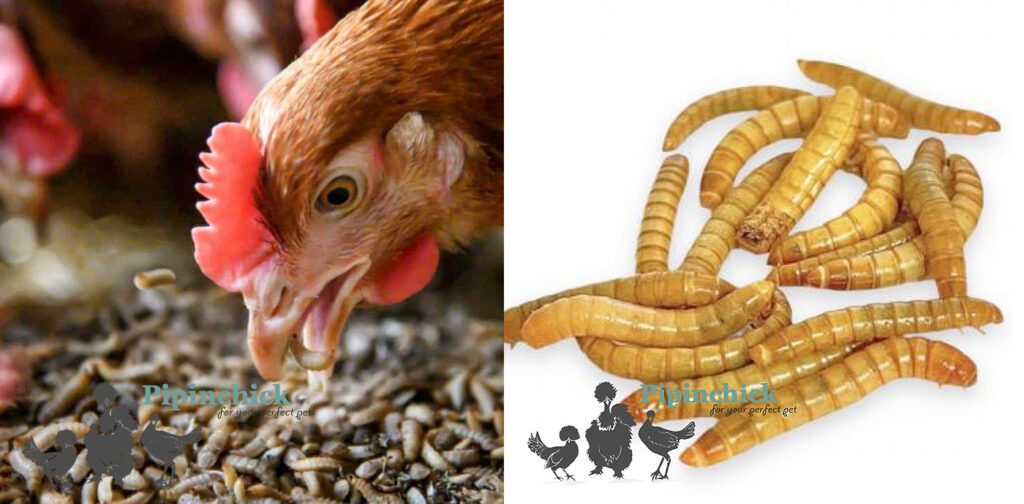
Why Feed Live Grubs to Chickens?
Adding live grubs to your chickens’ diet is a brilliant way to provide extra protein in a natural way. In the wild, chickens would feed on insects and larvae, so feeding them live grubs mimics this natural diet. The movement of the grubs encourages chickens to actively forage and scratch, keeping them entertained and reducing boredom, which is especially helpful in enclosed spaces.
Live feed also plays a role in overall hen health. Protein is essential for feather growth, egg production, and muscle development. Hens need even more protein when they’re moulting or laying, making live grubs a great addition to their daily feed routine.
What Types of Live Feed Can You Feed Chickens?
At Pipinchick, we offer a variety of live grubs for chickens, each with unique benefits for your birds:
Live Mealworms – A firm favourite with most chickens! Mealworms are high in protein and fat, providing an energy boost, especially in colder months. They are perfect as a treat or to encourage natural foraging behaviour. Shop live Mealworms for chickens here »
Live Calci Worms – These little grubs are a fantastic source of calcium, which is essential for strong eggshells and healthy bones. If you want to support your hens’ overall health while keeping their eggs strong, Calci worms are a great choice. Shop live Calci Worms for chickens here »
Live Mario Worms – A larger grub that takes chickens a bit longer to eat, making them a brilliant enrichment snack. They are packed with protein and have a meatier texture, keeping hens engaged for longer while delivering important nutrients. Shop live Mario Worms here »
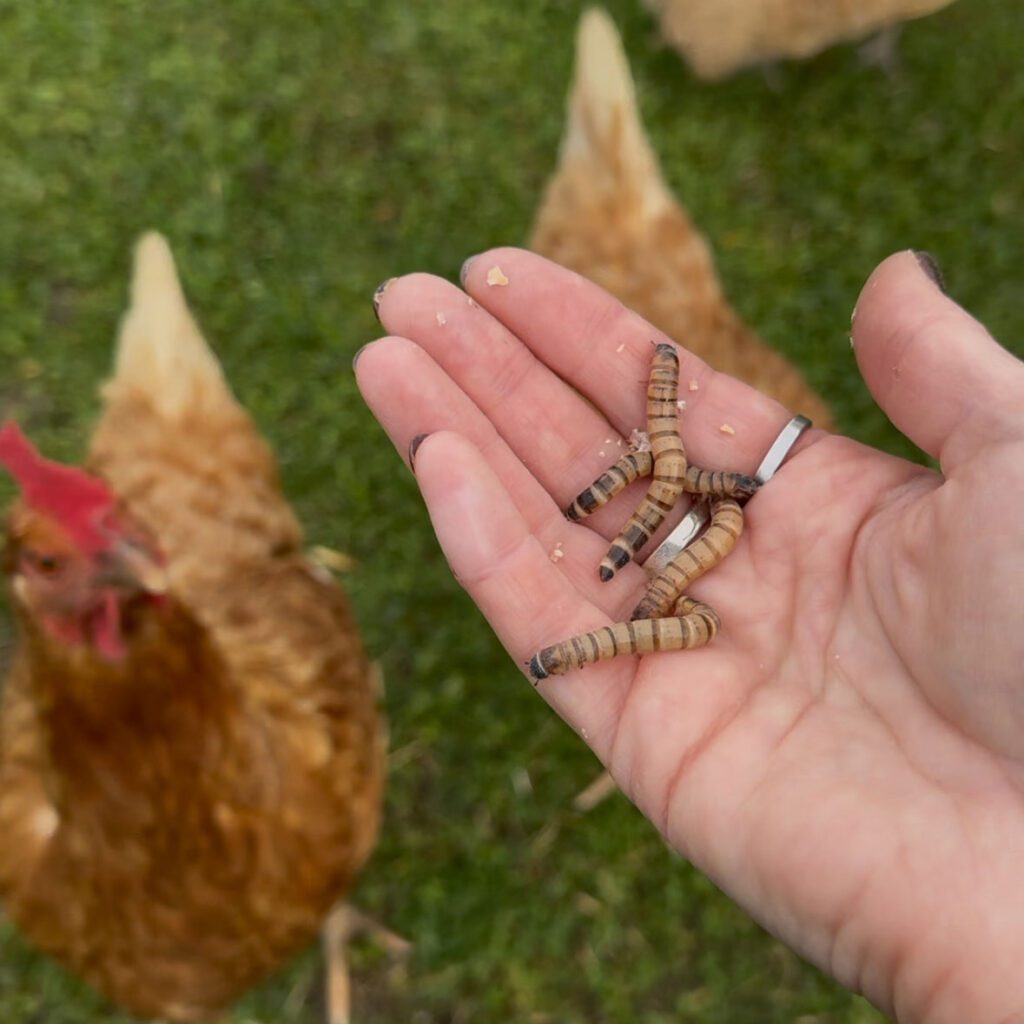
How to Feed Live Grubs to Your Chickens
Feeding live grubs to chickens is easy and rewarding. Simply scatter them onto the ground, and your hens will immediately start scratching and pecking as they hunt for their tasty snack. You can also mix them into your chickens’ regular feed or put them in a shallow dish.
Live feed can be given as an occasional treat or a more regular part of their diet, particularly during the colder months, moulting season, or when extra protein is needed. Just be sure to balance treats with their usual high-quality feed to maintain a well-rounded diet.
Happy Hens Means Healthy Eggs
Providing your flock with live grubs isn’t just about nutrition—it’s about encouraging their natural instincts, promoting activity, and keeping them happy. A well-fed, stimulated hen is more likely to lay delicious, nutrient-rich eggs, and there’s nothing better than knowing your birds are thriving.
At Pipinchick, we believe in giving chickens the best quality of life possible and adding the live feed to their diet is a fantastic way to enrich their day. Whether you choose Mealworms, Calci Worms, or Mario Worms, your hens will love you for it!
Take a look at our selection of live feed and treat your flock to something they’ll go wild for!
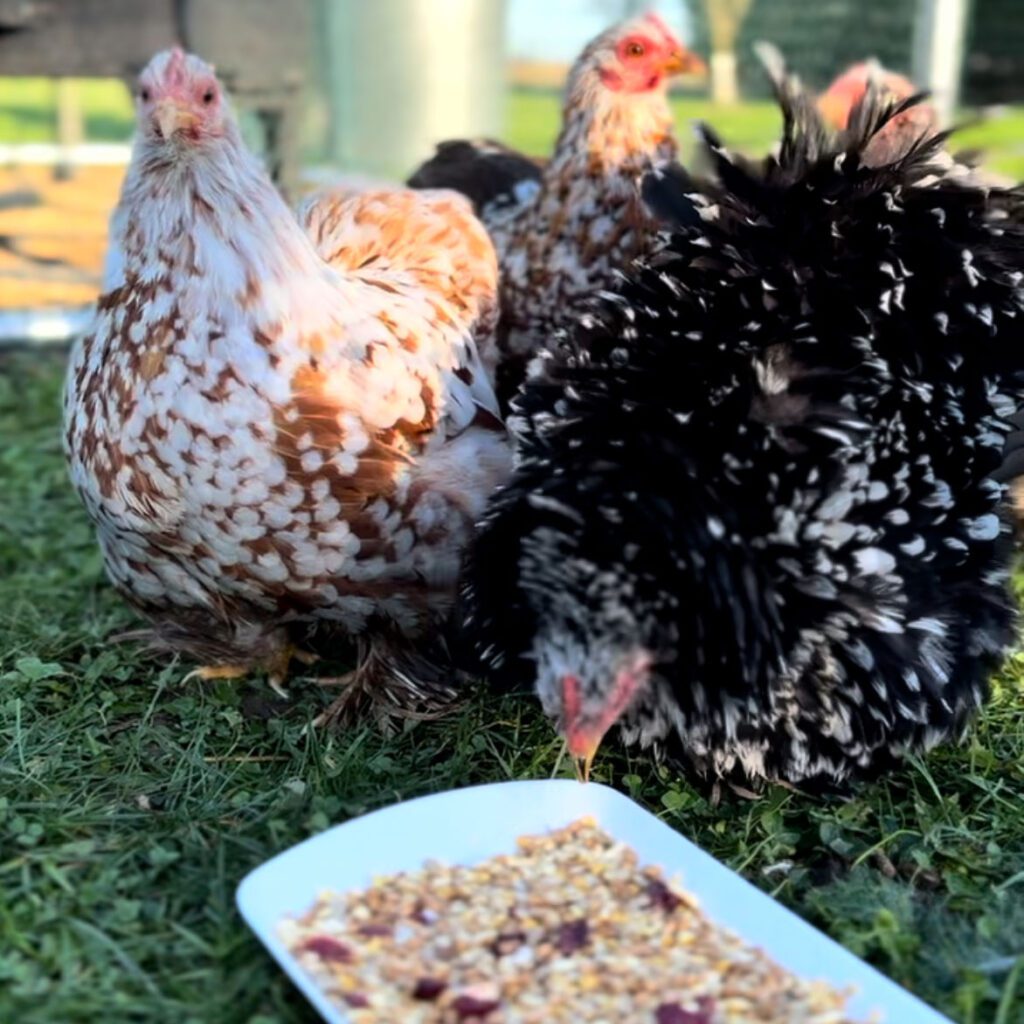
How to Keep Your Chickens Happy and Healthy During Flockdown
Avian Flu, or bird flu, is a contagious virus that affects both poultry and other wild birds. In response to a rise in cases, the UK government has introduced strict measures to protect both domestic and wild bird populations. As of Monday, 27th January 2025, several Avian Influenza Prevention Zones (AIPZ) have been declared in the UK. To check if your area is affected, you can check this interactive map.
This means if you are a bird keeper in any of these areas, whether you have a handful of hens in the garden or a large commercial flock, you must follow strict biosecurity rules to help stop the virus from spreading.
The Main Avian Flu Restrictions Currently in Place Include:
- Housing Requirements – All poultry and captive birds must be kept indoors or in a fully covered run to reduce contact with wild birds, which are a primary source of infection.
- Biosecurity Measures – Bird keepers must take extra precautions, including:
- Regularly clean and disinfect hands, clothing, footwear, and equipment before and after handling birds.
- Minimising movement in and out of bird enclosures.
- Storing feed and water in a way that prevents access by wild birds.
- Keeping the area free from vermin to prevent contamination.
These rules are legally enforceable and apply to all poultry keepers, no matter the size of their flock. While the UK Health Security Agency has assessed the risk to humans as very low, it's important to stay vigilant. Any suspected cases of Avian Flu must be reported to DEFRA immediately, which you can do here.
For the latest government updates and full guidance, visit the official website: GOV.UK.
What To Do If Your Chickens Show Signs of Bird Flu
Avian Flu spreads quickly, and early detection is key. If you notice any of the following symptoms in your flock, take action immediately:
- Swollen head, eyes, or neck
- Sudden loss of energy or appetite
- Blue discolouration of the comb and wattles
- Sneezing, coughing, or wheezing
- Diarrhoea
- Sudden and unexplained death
If your birds show any of these signs, report it to DEFRA (Department for Environment, Food & Rural Affairs). Do not move your birds, and avoid contact with other poultry keepers until you receive guidance on what to do next.
Keeping Your Chickens Happy and Healthy During Avian Flu Restrictions
All chicken keepers in Avian Influenza Prevention Zones (AIPZ) must follow the latest guidelines to protect their birds. Keeping chickens indoors or in a covered run is crucial to stopping the virus from spreading, but it can come with challenges.
Chickens love their routines. If they're used to free-ranging around the garden, they might get bored or even a little frustrated when suddenly confined to a smaller space. The good news is there are plenty of ways to keep them entertained, active, and stress-free while following the current guidelines.
Making The Most Of A Large Run
If you have space for a covered run, this will give your chickens more room to move around while staying protected. Here are some simple ways to keep the space interesting:
Perches at Different Heights – Chickens love to hop up onto things. Adding tree branches, wooden planks, or even an old ladder gives them places to roost and explore.
Hanging Greens – Tie up bunches of leafy greens like cabbage, kale, or broccoli. This keeps them busy pecking while also providing extra nutrition.
Dust Bath Areas – A shallow tray filled with dry soil, sand, and a bit of wood ash helps chickens keep their feathers clean and mites at bay.
Scratching Zones – Scatter some poultry-safe grains or mealworms into a pile of straw to encourage natural foraging behaviour.
Take a look at all of our range of walk-in runs here, and if you use code chickenrun2025 until the 28th Feb you can get 5% off.
Boredom Busters for Chickens
Chickens are curious creatures, and without their usual space to roam, they'll need a few extra distractions. Here are some easy and affordable boredom busters:
Chicken-Safe Treat Balls – A sturdy, perforated ball filled with corn or seeds makes a great toy that encourages pecking and movement. Take a look at our chicken treat balls here.
Mirrors and Reflective Surfaces – Some hens enjoy looking at themselves, and a small, securely fastened mirror can provide entertainment.
Logs and Branches – Arranging logs or branches in different ways encourages climbing and exploration.
DIY Pecking Toys – A plastic bottle with holes poked in it, filled with mealworms or grain, makes a great interactive treat dispenser.
Pumpkins or Melons – Cut in half and left in the run, these make for a tasty, time-consuming snack.
PoleTree Chicken Perch - A quick and easy to install, ready made solution to create a stimulating and sociable staircase of perches. Take a look at our PoleTree chicken perches here.
For more boredom buster ideas for chickens, you take a look at this article:
Pipinchick for Happy and Healthy Chickens
Keeping chickens isn't just about eggs – it's about enjoying their quirky personalities and giving them the best care possible. Chickens are intelligent, social animals, and a little extra effort during these restrictions will help keep them happy and engaged. With a bit of creativity, their temporary indoor life can be just as enriching as their usual outdoor adventures.
For more updates and tips on keeping your flock happy, you can follow Pipinchick on Instagram or Facebook. Take a look at our range of large chicken runs here (don't forget we have 5% off with code chickenrun2025 until the 28th Feb. We also have all the poultry supplies you'll need to keep your chickens happy and healthy during Flockdown and beyond.
Create Your Own Wishlist
Get the chickens you really want by using our online notifiers, create your very own chicken Wishlist and manage your online notifications by creating an account.
It couldn’t be easier to create your own chicken wish list.
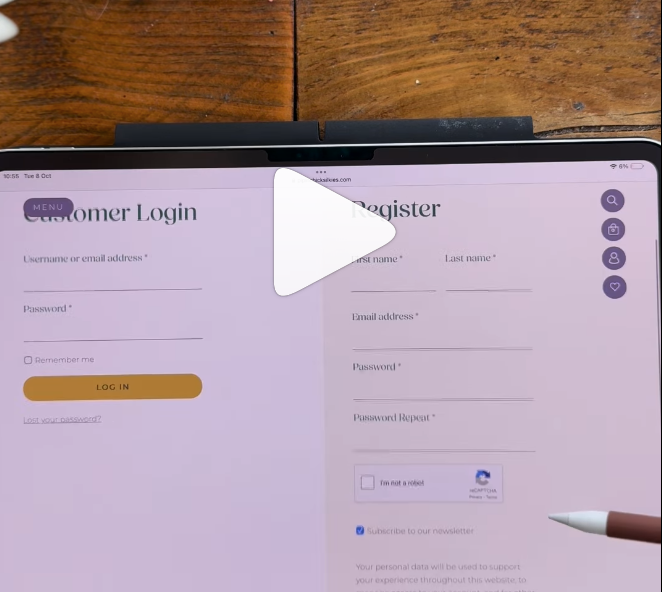
As we start to move beyond the cold and wet season of winter and we start to see the brighter and drier weather becomes more and more consistent, it is a good time for poultry enthusiasts to begin thinking about preparing the chicken coops for warmer weather. Below, we highlight several key factors to keeping your flock happy and healthy in the summer months.
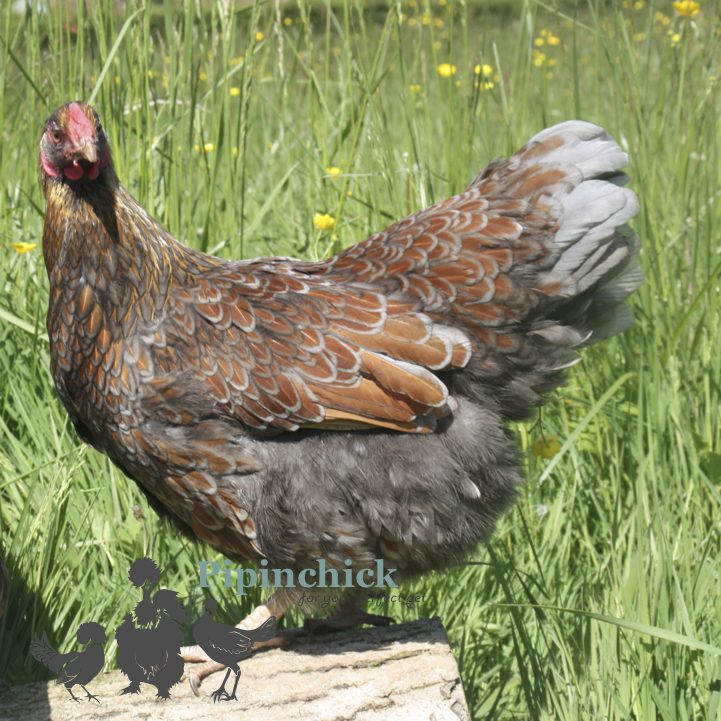
- Ventilation
During warmer weather, adequate ventilation becomes crucial in maintaining a comfortable environment inside the chicken coop. Unlike humans, chickens lack sweat glands and rely on panting to regulate their body temperature, so it is essential to prevent heat stress and respiratory issues through adequate ventilation. Check all ventilation holes are unobstructed and consider whether you need to install extra vents or windows.Optimal airflow can be achieved by ensuring vents are positioned higher than roosting areas to facilitate the escape of warm, stale air and encourage fresh air circulation.
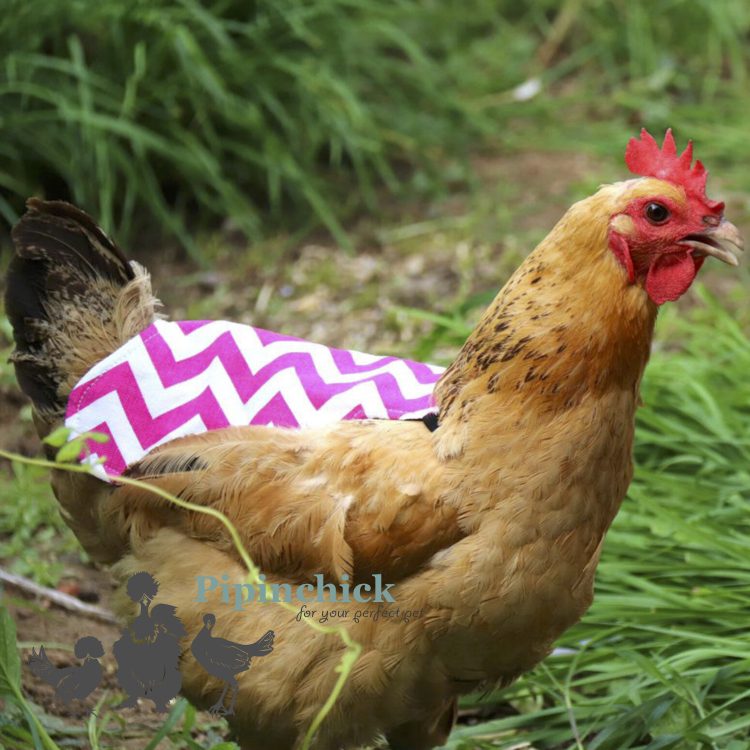
Note: A hen in danger of heat exhaustion will be panting heavily and holding her wings away from her body. She may have a pale waddle and comb, she may be lethargic, limp, or unconscious. A chicken exhibiting these symptoms is in extreme danger of dying from heat stress and needs to be cooled quickly.
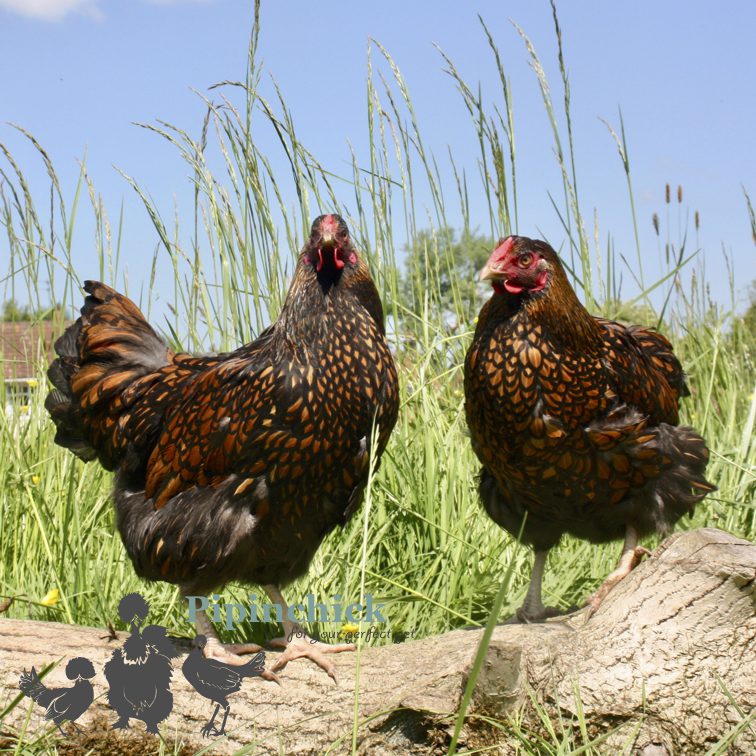
- Shade
Just as we seek shelter from the heat of the sun on hot days, chickens also require shade to avoid overheating. If your coop is based in a location exposed to direct sunlight, provide ample shade to keep the interior cool. You can create shade using cloth, tarps, or being clever with planting, such as arranging young trees or shrubs to provide extra shade for the coop and its surrounding area. Awnings or overhangs are another way to throw shade onto the outside areas such as the coop run. An area underneath the hen house, if this is raised, is a good option for escaping from the sun. Other ways to provide a cool place for your chickens is to use a parasol near the run or create a ‘den’ style shady area using chairs and a blanket. This is also a fun way of involving your kids.
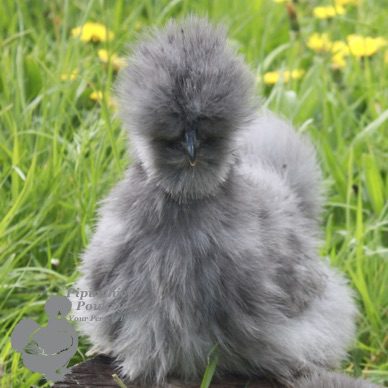
3. Water Management
Hydration is really important to keep on top of in summer for your chickens and cold water is going to be your hens’ best friend during the summer months. Chickens don’t sweat so they can overheat quickly especially in warmer weather and then they can quickly become dangerously dehydrated. To counteract the risk of dehydration, ensure a constant supply of fresh, clean water is readily available within the coop and run area. Spill-proof waterers are a good investment as they minimise wastage and help avoid contamination. You can also relocate your waterers to the shady areas and consider using insulation to keep their water source cool. Timetable regular checks throughout the day to ensure the water is cool and plentiful.
4. Dust Bathing Opportunities
Chickens have a predisposition to enjoy dust bathing as part of their daily grooming routine. It helps to control pests and keep feathers and skin healthy. Allowing plenty of areas for dust bathing becomes particularly important in warmer weather when parasites are more common. Regularly replenish the dust bathing material to keep it clean and effective in controlling parasites and offer up different areas, including one in the shade. We recommend checking your housing paying particular attention to perch ends, in the nest boxes and any cracks and crevices. If you find any red mites act as soon as you can to avoid them getting out of control to prevent them impacting on your bird’s health. A tip is to quietly look in the coop with a torch after dark – they mostly come out then. If you get a sheet of white paper and press any red mites you find onto it, red streaks will appear. To rid the coop of red mites, remove any litter and use a detergent to wash down, then allow to dry. There are also products that can be used to remove the Red Mite eggs, as well as the Red Mite.
5. Predator Prevention
Electric Netting -
Using electric netting for poultry has long been seen as the best. Electric netting fences keep both poultry in and predators out as they provide a 'blanket coverage' going from ground level up to 105cm. The gaps in the netting start off at 5cm horizontal spacings (even bantams won't escape through them) and get increasingly larger as they get higher.
Post & Twine / Wire -
Another very effective method of fencing in poultry and keeping foxes / dogs out and it has the advantage of being a more flexible method than using netting as it can hug the contours of the ground very easily. This method is not as effective at keeping smaller birds in as it doesn't hug the ground as closely as the netting and they can escape under the lines if they find a dip in the ground.
In summary
With careful planning, and consistent attention to your flock, summertime need not cause any extra worry, just more time to spend outdoors enjoying the better weather and your wonderful chickens. Here at Pipinchick Silkies, we have chickens for sale and hens for sale and like to do our very best to help our customers, whether or not they are new to keeping chickens, with any questions they have on suitability and environment.
Getting mites in your coop is pretty heart breaking, your poor hens will be itchy and uncomfortable. Red Mites along with other mites live on the bird but can
Chickens are becoming increasingly popular as pets in the UK as they are fairly easy to look after, have tremendous personalities and also give a little something back in the form of delicious eggs. We love every chicken we raise on our farm and want to make sure that each home they go to has a good idea of the best way of looking after our beautiful chickens. We are able to give you advice in person or via phone or email to make sure your chickens stay healthy and happy.
Before You Buy Chickens
It is important to get to grips with some basic facts about keeping chickens before rushing out and buying them. Chickens require attention every day, much like any other household pet. You should of course consider the size of your garden and whether it is suited to keeping chickens. Keep in mind, where are they going to sleep, where they will be allowed to roam, how to keep them fed and watered if you are way for a period of time and how to keep them safe from foxes and other potential predators. Once you have decided that keeping chickens is definitely something you would like to do then preparing their habitat before they arrive is important.
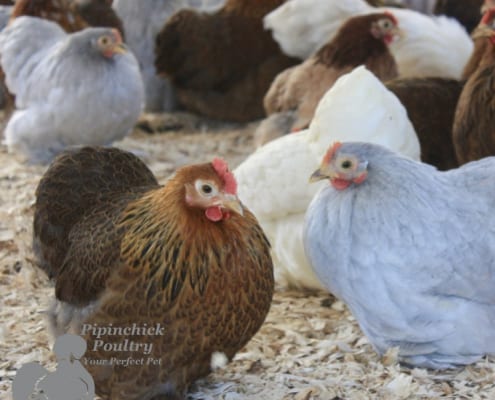
Buying a chicken house
This is likely to be the most expensive outlay for keeping your chickens and there are many different sizes and designs on the market available for you to purchase. It is often a case of getting what you pay for and cheaper houses will require regular wood treatments and other maintenance to ensure they are kept in good condition for keeping your chickens safe and warm inside. When purchasing a chicken coop inspect the quality and thickness of the wood which is a good indication of how long the coop will last. It is also possible to build your own coop, if you are so inclined. You should also check the coop has nest boxes, appropriate ventilation and perches for the birds to roost but also keep in mind the box will require regular cleaning and maintenance. And access should be easy for you to do this. The floor of the house can be covered in wood shavings, straw or chopped cardboard to keep the birds warm. Take a look at our different types of chicken houses for sale online
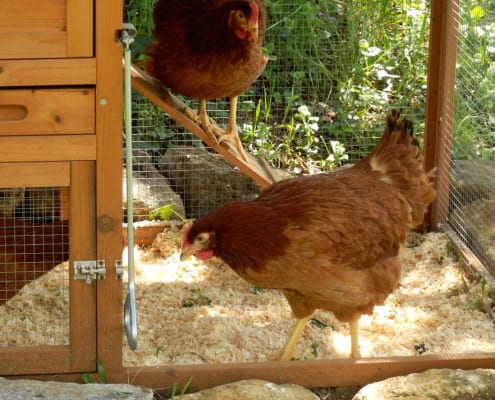
Chicken Access Areas & Safety
Chickens also require access to areas where they are able to stretch their legs. Many people allow their chickens to roam free around their gardens, which is ideal. There is also the option building a chicken run which should be built as large as possible to keep the birds happy. It should also be built securely, again to defend against predators.
We have already covered the importance of keeping your hens safe from predators and a couple of considerations to bear in mind when providing them with a home and exercise area. There are other ways you can keep the animals safe such as an automatic po-hole opener which will automatically open and close the doors of the house based on a timer to ensure that your chickens are safely locked inside the house at night and it will also open in the morning to let the chickens out.
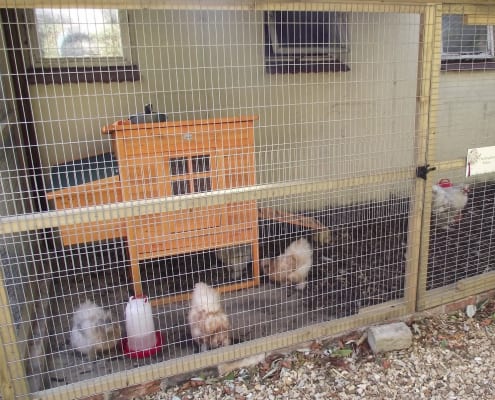
Feeding Chickens
There are some brilliant, nutritionally balanced chicken feeds available to keep your chickens in the best possible condition. Many people believe that you can feed chickens on food scraps and let them forage for the rest, however, it is likely that they will miss out on important nutrients which is why we always suggest using formulated feeds. Layers Pellets are the best solution, although cheaper ones, such as mash, are available. If you are keeping a significant number of birds ensure there is enough space at your chicken feeders, or that you have enough feeders, for all of your birds, as the pecking order may mean that some chickens may miss out on food. There are certain plants, such as rhubarb or potato leaves, that are poisonous to chickens. Ask us for a full list of these items. Keeping your chickens well fed on a nutritionally balanced diet is also good for you as they will produce more eggs! We sell large range of excellent quality chicken feed, take a look at our range of chicken corn and feed here.
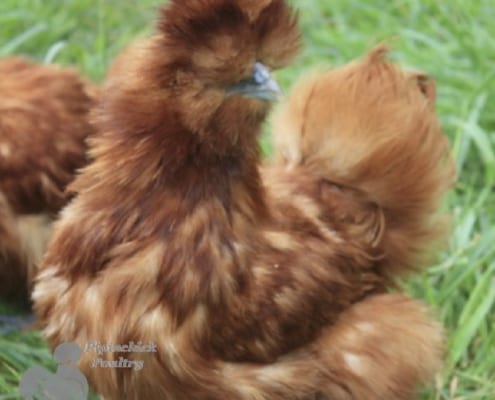
Keeping your chickens Hydrated
As with any living thing, keeping your chickens well hydrated is of the utmost importance. You should ensure that the chickens always have enough clean drinking water. Similar to with the feeders, you should ensure that there are enough water containers for all of your chickens to have a drink, regardless of the pecking order. Containers should be large enough to last all day, with a bit left spare. Many people also add a splash of apple cider vinegar to the water which is proven to be good for chickens. You can buy specially designed poultry drinkers which will help to ensure your flock stays hydrated and healthy.

Choosing Your Chickens
Now comes the fun bit, choosing which chickens you would like to keep. We have a beautiful range of chickens from you to choose from including Silkies, hybrid chickens, bantams hens, large pure bread chickens and more. You can view our buying guide here or give us a call and arrange a visit to see the chickens in the flesh!
Keeping Chickens in the Garden – Five Common Myths Debunked
Chicken-keeping really is a fascinating and rewarding world to be involved in and here at Pipinchick Silkies, we know a thing or two about these wonderful birds and just what they are like to look after. We often come across the same questions that beginners to chicken-keeping have and so in this post we delve deeper into the true delights of owning chickens, get stuck into the detail and de-bunk the top five myths!

Myth 1 – Chickens are smelly and dirty!
Actually, chickens are really rather clean and tidy! Of course, any living creature can create a mess, but it really is not the case that keeping a small number of chickens in your garden, if properly looked after, need to be either smelly or dirty at all. You simply need to make sure they are cleaned out regularly and their bedding replaced. If you maintain their coop well, there need not be any nasty odour from your feathered friends at all (and they will probably love you all the more for doing so!). Plus, what mess they do make, in terms of their droppings can be really rather useful if you are into your gardening.

Myth 2 Keeping chickens will attract rats to my garden!
Keeping a few chickens in a coop in the garden is no more likely to attract rats to your outside space than feeding visiting birds, since it is the food source that can attract rodents, rather than actually keeping chickens as such. It is very straight forward to minimise the risk of unwanted visitors, you just need to ensure that any food kept near the coop is properly stored in containers which are rodent proof. Rats are opportunistic and will not hesitate to dig holes in bags of feed to get their paws on it, but a container that cannot be ripped or burrowed into is an instant deterrent.

Use a well-designed chicken feeder for your flock; a treadle feeder is a silent feeder which only releases food for the chickens when they activate it, making it much more effective at keeping the food away from any rodents. This type of feeder also reduces waste since it only dispenses food when the birds want it. Rats are not heavy enough to activate the treadle plate so once your chickens have got the hang of using such a feeder their food is safe from other such visitors.
Of course, removing any eggs from the coop is essential too, so be sure to collect them daily so that any rats are not tempted to get access and take them. Since rats can be dangerous to chickens, you will want to ensure there is no chance of them nesting underneath, so elevate the coop from the ground and make sure to regularly check the coop for holes or gaps that rats could exploit.

Myth 3 – Chickens will be noisy and annoy the neighbours
Unlikely, since hens only cluck very softly, mostly in the morning, or when they are laying eggs or communicating with each other. Some breeds are more vocal than others, so if noise is a concern you may want to select a quieter breed, such as Ameraucana.
If you are worried about roosters, who are certainly rather noisier (and they do NOT only crow at dawn, since their role is to warn of danger amongst other things) then you do not need to keep any of these, your hens will lay eggs perfectly well without them, these eggs are just infertile and cannot develop into chicks. If you do have a rooster, then eggs need to be collected daily and kept in a cool place, so that they do not develop into chicks.
Myth 4 – Chickens will wreck the garden
In fact, chickens can be a real asset to your garden, they will happily eat insects, snails and weeds. They scratch at the soil, which can both aerate it and reduce pests. If they are allowed to roam where you plant too, they will leave droppings which act as excellent fertilizer for many plants. Otherwise, you can add these droppings to your compost to help enrich this.
Of course, free roaming hens are happier hands, so to some extent, space does matter but if you do not want the chickens to have complete freedom in your garden, then they will be pretty content with at least 10 square feet to roam in, adjusted based on breed and coop design of course.
Myth 5 – Keeping chickens will mean fresh eggs every day
Egg production really varies. Some hens take a long time before they become comfortable enough to start laying and then there are significant differences between breeds. Some, such as our Ardennaise Bantams lay more consistently, up to 180 small white eggs a year, or for a more cuddly option, the Bearded Silkie, with up to 100 medium eggs annually. Depending on how much of a pet you want your chickens to be, whether you have children, want a garden companion, all of this will help determine the right birds for you, not egg production alone.
Egg production also varies seasonally, chickens lay fewer eggs during winter due to the reduced daylight hours. Annual molting that chickens undergo will also affect how many eggs are produced as will the general health and age of your hens. If you are interested in keeping chickens just for the eggs then you need to be fully aware that the eggs can be somewhat inconsistent.
Here at Pipinchick Silkies, we have chickens for sale and hens for sale and like to do our very best to help our customers, whether or not they are new to keeping chickens, with any questions they have on suitability and environment. We will help advise you on which breeds are likely to get along, what you need to do to give your birds the best start in their new homes and we offer all our customers 100 percent aftercare too, so if after reading these debunked myths there are any other pressing questions you have, do not hesitate to get in touch, we would love to help you out!
Keeping Laying Hens Healthy in Spring!
Keeping your laying hens healthy as we approach spring, it is important to look at your hens’ overall health and put some provisions in place to ensure they transition from winter to spring with ease. As the daylight hours increase your hens will begin laying again, ensuring they have enough nutrients in their diet and a clean and parasite free environment will be crucial during this period.
Here at Pipinchick Silkies, the team have put together some tips to ensure the best health and wellbeing for your laying hens during this seasonal transition.

1. Clean and Maintain the Coop
– Spring is the perfect time for a thorough cleaning of the coop. Remove old bedding, clean surfaces with a good poultry cleaner, and disinfect with Virkons.
– Check for any signs of wear and tear in the coop structure and repair as needed.
– Ensure proper ventilation to prevent respiratory issues.

2. Dust Bath Area
– Stress due to mites can reduce egg laying by 10-15 percent
– Provide a dust bath area for your hens. This helps them control mites and parasites naturally.
– You can use a mix of sand and diatomaceous earth in a designated area for them to dust bathe.
– This must be kept dry.

3. Check for Parasites
– Regularly check your hens for signs of mites, lice, or other parasites. Treat, if necessary, with appropriate products.
– Consider adding diatomaceous earth to their dust bath, as it can help control external parasites.

4. Spring Diet
- Adjust their diet to meet the increased nutritional demands of laying during spring i.e. higher protein and more vitamin D.
- Provide a balanced layer feed with sufficient calcium.
- Offer fresh greens, vegetables, and fruits to provide additional nutrients.
- Offer additional water-soluble Calcium tonics such as Agrivite Feather Shell and Bone and offer treats with extra oyster shell.
5. Monitor Egg Production
- Keep track of egg production and watch for any abnormalities
- A sudden decrease in egg production or changes in egg quality can indicate health issues.
- Ensure a proper nesting environment to encourage laying in appropriate places.
6. Health Checks
- Conduct regular health checks, looking for signs of illness such as lethargy, changes in eating habits, or abnormal droppings.
7. Provide Adequate Water
- Ensure a clean and abundant water supply.
- Hens need ample water for egg production and overall health.
- Clean water containers regularly to prevent the growth of harmful bacteria
8. Preventative Measures
- Implement biosecurity measures to prevent the introduction of diseases.
- Control access to the coop and run to reduce the risk of disease transmission.
- Quarantine new birds before introducing them to the existing flock.
9. Natural Lighting
- Spring provides longer days, which can positively influence egg production.
- Ensure that hens have access to natural light, every day, during the day.
10. Observe Behaviors
- Spend time observing your flock's behavior
- Healthy hens will be active, alert and engage in normal activities.
- Address any behavioral changes promptly, as they may indicate health issues.
By paying attention to these aspects of care, you can help ensure that your laying hens remain healthy and productive during the spring season. Regular observation and prompt action are key to addressing any health concerns that may arise. For more information about chickens for sale and hens for sale, contact the Pipinchick Silkies team here.
If you want to buy chickens or hens before you make your purchase it is prudent to think about the practical ways in which you can care for them in cold weather. Here at Pipinchick Silkies, we put together five essential things all purchasers should consider:

1. Damp and draught free shelter
Ensure that the coop, where you plan to house your chickens, can stay dry and free of draughts throughout the winter months. Well-insulated coops with closed windows and partially closed vents are a good way to maintain adequate ventilation without creating cold drafts, which can lead to your chickens becoming unwell or get frostbite.

2. Extra Litter Insulation
During colder months you can insulate your chicken house with extra layers of cardboard and bedding. Simply add extra layers of cardboard to the bottom of your chicken coop and then put a very thick layer of your bedding on top, we recommend either a heat sealed treated straw bedding such as Dengi Fresh Bed, or a good quality wood shaving like Mendip New Flake. This will create a warm base for your chicken house, you can then insulate the roof by placing a lined picnic style blanket over the roof on the outside. This will keep your hens toasty warm during colder months.

3. Nutrition
When you buy chickens, preparing stores of good nutrition is very important during colder months. Adjust your hens’ diet by providing higher quality and increased quantities of feed to help them stay warm. Offering cracked corn or grains in the afternoon can provide additional warmth as their body burns the extra calories through the night. Check the coop every day and ensure there is always access to fresh and unfrozen water.

4. Prevent Frostbite
If you're planning to purchase chickens, be aware of the potential for frostbite. Applying petroleum jelly to the combs and wattles creates a protective barrier. Additionally, check that roosts are wide enough to prevent contact between their feet and the cold surface, safeguarding them from frostbite on their toes.
Finally, ensuring good ventilation and gentle circulation of air will help keep the coop smelling good and promote dry air within the coop. Dry air makes it easier for chickens to stay warm and prevents your chickens from getting frost bite.
5. Monitor Egg Production
When you buy chickens for the first time, it is a steep learning curve and whilst it is exciting to see your first egg production, you can expect a natural decline during winter. This said, you should still expect your hens to be laying regularly. Added to this, by collecting your eggs in frequently, you will prevent freezing and cracking. If there's a significant drop in production over the colder months, investigate potential causes such as stress, illness, or nutritional deficiencies in the hens for sale.
By keeping the above tips in mind and factoring in daily checks to your chickens, you can expect happy birds, even in colder weather conditions. Through regular monitoring and adjustments based on your chosen breed of chickens, you will ensure a happy, healthy and productive flock.
For more information about chickens for sale and hens for sale, contact the Pipinchick Silkies team here.
Top Five Accessories for Happy Chickens!
Creating a happy and healthy environment for your chickens involves providing the right accessories. At, Pipinchick Silkies, we sell chickens and hens, but the wellbeing of our feathered friends is truly important to us so our team look the top five chicken accessories that can contribute to their happiness.

1. Nesting Boxes
Nesting boxes are essential for providing a safe and comfortable space for hens to lay their eggs. These boxes offer privacy and help keep eggs clean, reducing the chances of breakage or dirty eggs. A general guideline is to have one nesting box for every three to four hens.

2. Feeder and Water
Proper nutrition is essential for chicken health and happiness. Invest in high-quality chicken feeders such as chicken pecker balls, chicken pecker blocks, seaweed supplements, mixed corn which can be fed to poultry and chicken drinkersthat are easy to clean and keep the food and water fresh. Hanging feeders and waterers can help prevent contamination and spillage. Ensure a steady supply of fresh water and nutritious feed.

3. Dust Bath Area
Chickens love to take dust baths to clean their feathers, control parasites, and enjoy some relaxation. Provide a designated area in your coop or run filled with fine dust, sand, or dry soil. You can also add wood ash or diatomaceous earth for pest control. Chickens will appreciate having a place to roll and preen in comfort.

5. Perches or Roosting Bars
Chickens naturally roost at night to sleep. Providing roosting bars or perches in the coop gives them a safe and elevated place to sleep. Make sure the perches are flat and wide enough for your chickens to balance comfortably. Ideally, allow around 8-10 inches of roosting space per bird.
6. Toys and Enrichment
Chickens are curious birds that benefit from mental and physical stimulation. Consider adding various toys and enrichment activities to their environment. Hanging chicken treat bags, mirrors, or even simple objects like a cabbage or a flock block can entertain your chickens. These distractions keep chickens from getting bored, which can lead to pecking and other negative behaviors.
These accessories, when combined with a clean and safe living environment, contribute to your chickens’ happiness and wellbeing. They ensure that your chickens have a comfortable place to lay eggs, rest, socialise, and entertain themselves. Happy chickens are not only more content but also tend to be healthier and more productive in terms of egg-laying.
Pipinchick Silkies have chickens for sale and hens for sale so please contact the team for more information.

